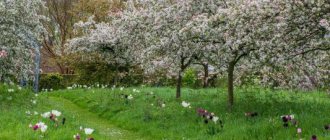This unusual cabbage can rightfully be called a plant for the lazy. It does not lose its beauty even at the beginning of winter during frosts. Today there are many varieties and hybrids of ornamental cabbage that landscape designers love.
Ornamental cabbage is a type of vegetable cabbage. However, this attractive plant looks less like a banal vegetable and more like a bright flower. Thus, the leaves of some varieties look like rose petals. In addition, ornamental cabbage pleases with a variety of colors. See for yourself!
Piglon
Spreading variety with a compact rosette. Resembles a rose bush with smooth leaves. The lower tier of leaf blades is colored green along the edges, characteristic of ordinary white cabbage. Closer to the core of the inflorescence, the greenish tone smoothly turns into milky white and cream shades. Each leaf has a regular round shape, and closer to the center it tapers at the tips, giving the cabbage an appearance similar to the queen of flowers.
How to use in landscape design
Decorative rosettes of cabbage will perfectly decorate the garden in autumn and winter. There are several options for its use:
- You can plant them on the edges of a flower bed or ridge, along paths, where they will form a small hedge. It is better to plant cabbage in groups to emphasize its extraordinary beauty.
- Lacy cabbage is great for growing in pots on balconies alone or in combination with other frost-resistant species.
- Individual cabbage plants remain fresh in a vase for a very long time, so it can be used for bouquets (especially smaller specimens).
- They can decorate the garden in late autumn and winter; unlike chrysanthemums, they are not so sensitive to frost.
- Cabbage is also used in urban landscaping - in parks and flower beds.
Ornamental cabbage bushes are a valuable addition to autumn flower beds and look beautiful with:
- chrysanthemums,
- ashen ragwort,
- common heather,
- pansies,
- ornamental grasses.
Sunrise F1
Another decorative variety of cabbage, the rosette of which resembles the shape of a blossoming flower. It has a rich range of colors, combining pink, green, bright orange and light shades.
The plant is tall and therefore needs support. The long stem, decorated with small leaves, ends in a large white-yellow bud with a multi-colored core.
In addition to its spectacular appearance, this variety is famous for its unpretentiousness to growing conditions and requires watering only a couple of times a week. It is also popular among gardeners due to its frost resistance and ability to bloom until the first days of December.
Decorative cabbage: lace and ruffles in the flower garden before winter
Landing
Young brassica seedlings require coolness at the initial stage of growth, so the easiest way is to sow the seeds in mid-April in a greenhouse or under a film cover on the site, and then plant the seedlings in the right place.
If you need to get lush rosettes earlier, this crop is grown at home, sowing in mid-March. Ornamental cabbage can be sown directly in open ground. To do this, pre-wetted seeds are sown in a prepared container filled with loose fertile substrate. You can purchase such a soil mixture in a store or prepare it yourself by mixing leaf soil, humus, peat and river sand in equal proportions and adding a couple of glasses of sifted wood ash to a bucket of this composition.
To avoid subsequent picking, it is easier to immediately plant ornamental cabbage in separate containers - cups or cassettes. With this approach, 2 seeds are placed in each cell, deepening them by 0.5-1 cm, and after germination, the weaker sprout is removed.
Brassica seedlings in cassettes
Before the emergence of seedlings, the containers are provided with a temperature of +18...+20°C (in such conditions, sprouts appear in 3-5 days), and then the regime is changed. In the first week, seedlings are kept during the day at a temperature of +10...+12°C, and at night at +6...+8°C. Subsequently, the daytime temperature is maintained at +13...+16°C, and the night temperature +8...+10°C. After the emergence of seedlings, the seedling container is moved to the lightest window sill, but in cloudy weather, as well as in the mornings and evenings, the plants are additionally illuminated with fluorescent lamps.
The soil must be constantly kept moderately moist. During your stay at home, it is good to feed the plant a couple of times with any complex preparation according to the instructions. This is done 10-12 days after germination and again 12-14 days later. Hardened seedlings are planted in open ground at the end of April or in May (depending on the region).
Seedlings are planted in the ground at the end of April or in May
This crop, unlike its closest cabbage “relatives,” tolerates transplantation much better. Therefore, seedlings can be planted immediately in a permanent place or in a separate bed in the far corner of the garden, and in the second half of summer, adult plants with a large lump of earth can be transplanted into a flower bed.
Brassica tolerates a little shade, but it turns out more spectacular if it grows in the sun, so it is better to plant it in an open area. It is also worth taking care of the composition of the soil in the garden. It must be generously fertilized with humus or compost (about a bucket per 1 m²), add any complex mineral preparation according to the instructions, and if the soil is acidic, be sure to add wood ash for digging (up to 0.5-0.6 kg per 1 m²). Ash, as well as dolomite flour, can be added as a deoxidizing agent in the spring, but fluffed lime must be incorporated into the soil in the fall.
Seedlings are planted in holes by transferring them from glasses. Photo from lockerdome.com
Seedlings are transferred from glasses to holes located in a checkerboard pattern at a distance of 30-60 cm from each other (depending on the variety). Plants are buried in the soil up to the first leaves, the soil is compacted around them and watered abundantly.
Lace frill
One of the most attractive varieties of ornamental cabbage delights gardeners with its beauty until the first snow falls. It grows up to half a meter and has openwork leaves that resemble a lace collar.
The rosette is painted in all shades of pink and purple. The lower tier of leaf blades has a rich green color. The tone of the frills along the edges of the leaves varies from greenish to purple or deep pink.
Recent Entries
Lilac perennials that are beautiful, compact and do not crowd out other plants Why when buying seedlings you should not take the sellers’ word for it and how to determine the age of the plant using 3 signs Tomato seedlings have turned purple or whitish: why the color has changed and how to save the plants
Peacock Red
The variety looks great in the autumn garden. A large rosette of serrated leaves that look like outlandish feathers will become a bright accent in a flowerbed or in a mixborder.
The variety tolerates low temperatures and high humidity well; moreover, it is with the onset of cold weather that the greens turn bright colors.
For the winter, the plant can be transplanted into a container, and it will remain decorative until the New Year. Peacock Red is ideal for single and group plantings.
Tokyo
A hybrid variety resembling the shape of a blossoming peony. It has a dense and multi-layered rosette consisting of rounded leaf plates. It grows no higher than 35 cm, but is quite spreading.
The color palette of the openwork leaves of the rosette consists of rich shades: pink, burgundy-red, milky white. The lower leaves are gray-green with subtle hints of purple.
Assol
The plant has a compact rosette with a diameter of about 45 cm. The height of the cabbage does not exceed 35 cm. The color in the center is yellow-white, green at the edges.
Assol is resistant to low temperatures, diseases and pests. The bud is quite lush, the leaves are wavy, the crop can decorate any front garden or flower bed. Flowering is especially spectacular in late autumn, when other plants have already faded.
Spoonbill
A decorative variety of cabbage often used to decorate flower beds, flowerpots, and ridges. The rosette is shaped like a rosebud that has opened its petals. The color is soft pink with subtle hints of purple. The height of the plant does not exceed 50 cm, but the plant stands out among others due to the splendor of the inflorescence.
It is unpretentious and frost-resistant. It calmly tolerates the first frosts, temperatures down to -10 degrees Celsius and survives until the end of the autumn season, when many other cabbage varieties are already withering. Closer to summer, the color of the platinum sheets becomes more saturated.
Flowering varieties
Brassica is a non-flowering plant, so we cannot talk about full-fledged flowers. Flowering is the period of the highest decorative properties of cabbage. Most often it falls in August - October of the first year after planting.
Ornamental cabbage looks like flowers.
Brassica is planted in the second year solely to obtain seeds. At this point, all the ornamental cabbage shoots out arrows, on which boxes are formed, where the seeds ripen. Some gardeners call these baskets flowers, which is incorrect.
Question to the author of the site from reader Sergey
Which ornamental cabbage, in your opinion, is the most beautiful?
Many varieties of cabbage have decorative properties. But my favorite is Piglon. From a distance it is indistinguishable from a rose.
Robin
One of the largest and tallest mid-season varieties with petioles up to 100-150 cm and a rosette diameter of about half a meter. The leaves are elongated, corrugated, lacy at the edges, slightly drooping. Coloration varies from dark purple to muted burgundy. It is popular among gardeners not only for its spectacular appearance, but also for its pleasant taste.
- Author: iarriba
Rate this article:
- 5
- 4
- 3
- 2
- 1
(0 votes, average: 0 out of 5)
Share with your friends!
Growing conditions
Soil requirements
Ornamental cabbage requires soil:
- fertile;
- well drained;
- wet;
- with a reaction from slightly acidic to alkaline (pH 6-7).
It grows well in soil enriched with rotted manure or compost. Due to the late planting time, green manure - green manure - can be sown in the area prepared for cabbage in the spring. Since cabbage requires a soil reaction close to inert for proper growth, on acidic soils in the fall of the year preceding cultivation, it is worth calcifying the substrate. This procedure should not be carried out together with autumn fertilization with manure, as this can lead to large losses of nitrogen.
To prevent diseases and pests, it is extremely important to observe a minimum four-year crop rotation - do not plant cabbage after plants from the cabbage family earlier than 4 years.
Sunlight, temperature
The cabbage planting site should be well lit by the sun. However, the growth and formation of heads and rosettes is negatively affected by heat - the optimal temperature for the formation of heads of cabbage is 15-20 °C. Autumn frosts work in favor of the appearance of plants, since it is under their influence that cabbage leaves begin to become decoratively colored. Only long-term temperature changes below -5 °C lead to destruction of the heads.
Description of the plant
Ornamental cabbage looks somewhat like a flower, although in fact it is a perennial crop of the Cruciferous family.
It is difficult to give a general description for this plant, since there are 5 main types of ornamental cabbage: rosette, brain, needle, head and half-head (Figure 2).
Note: All these species differ from each other in height, inflorescence shape and shade of leaf blades, although the flowering itself lasts approximately the same time. Regardless of the species, the plant has a tap root system and a dense stem of short height.
The leaves are large, collected in a rosette at the base. The center of the leaf rosette rises above the side leaves and is shaped like a flower. That is why this plant is often grown in the country as an unusual decoration.
Figure 2. A distinctive feature of the plant is its brightly colored leaves.
It is noteworthy that the plant fully reveals its decorative properties only towards the end of the growing season. By the end of summer, the leaves acquire a richer and brighter color, and this color persists until late autumn. There are many hybrids of ornamental cabbage, but in most cases the leaves are colored ashen, pink, purple or bluish.
Original cabbage for a flower bed with photographs and descriptions
Depending on the variety, lace heads of ornamental cabbage can be miniature or reach a height of 50-60 centimeters. Ornamental cabbage appears in all its glory in the flowerbed when other flowers are already beginning to dry out.
Cabbage decorates the garden plot until frost, and a slight sub-zero temperature is good for it. Breeders have bred about a hundred species of decorative leaf and cabbage forms. This article presents several of the most interesting varieties.
Lace frill
The cabbage variety Lacy Jabot has corrugated leaves that resemble a frill collar. The leaves of the variety are tricolor, with a smooth transition from green to deep lilac. The variety reaches full development by September, and multi-colored laces delight the eye in the flowerbed throughout October and early November.
Cabbage Lace frill is a plant about 50 centimeters high. The leaves of the variety have a clearly defined corrugated edge.
Peacock
Peacock is one of the most spectacular varieties of ornamental cabbage. The head of this variety reaches a diameter of 30-35 centimeters, and the span of the outer leaves is 70 centimeters. The structure of Peacock cabbage leaves resembles feathers.
The lower leaves are colored bluish-green, the central leaves and head of cabbage are white or pinkish. The color has clearly defined boundaries.
Tokyo
The Tokyo series of cabbage varieties are distinguished by a very bright center framed by rich green foliage. The green leaves framing the bright head of cabbage have a rounded shape and slightly corrugated edges.
The leaves in the center are covered with multi-layered fringe of purple, dark pink or violet. The height of the plant is about 30 centimeters. The rosette of leaves is multilayered and dense.
Osaka
The Osaka variety is similar in shape to Tokyo cabbage. In terms of color, there are three varieties, depending on the color of the leaves of the inner rosette: white - creamy white, pink - pink, red - red. The marginal leaves of all varieties are bluish-green.
A distinctive feature of the variety is the increased corrugation of the leaves along the edges. The volume of a rosette of Osaka cabbage reaches 45 centimeters. Plant height is 55-60 centimeters.
Sunrise
The variety of decorative cabbage Sunrise has a very attractive shape. Its heads look like giant roses. A small head of cabbage with half-opened leaves is colored marbled white, lilac, pink or yellow.
Some leaves are additionally decorated with dark edging. The outer, framing leaves are rich green with a slight bluish coating. The stem of cabbage is tall, can reach 90 centimeters, so the plant looks like a real flower.
The Sunrise cabbage variety reaches its greatest decorative value at temperatures ranging from plus 12 and below. The rosettes begin to color and turn into real flowers. Cabbage does not lose its decorative effect until snow falls.
Lark's tongue
Lark's Tongue cabbage is not like a regular vegetable with a head of cabbage. This is a leaf-shaped variety. Forming a stem with a height of 50 to 130 centimeters. On the stem, petiolate shoots about 20 centimeters long are formed, covered with curly leaves. The color of the leaves is green.
The Lark's Tongue cabbage bush begins to grow in the second half of summer. When fully developed, the cabbage bush resembles a palm tree from a distance. The plant remains decorative until the first snow falls.
Piglon
Piglon is an unusually beautiful variety of ornamental cabbage. Small heads of cabbage look like rose buds. The plant is compact, with a traditional shape for ornamental varieties of cabbage, on a long stem.
The outer leaves of the cabbage are dark green with pronounced white veins. Medium ones are creamy white. In the center is a pale pink rosebud-shaped rosette.
Spoonbill
Pink Heron is one of the most spectacular varieties of ornamental cabbage. The stems of the plant are long and oblong. Rosettes of bright pink color resemble pink buds framed by rich green covering leaves.
Cabbage reaches its greatest decorative value at the end of summer and remains fresh until frost. The variety can withstand short-term frosts down to minus 10-12 degrees.
Red kale
Red kale is a variety with beautiful purple leaves. There are carmine, brown, ruby and even violet-black shades. The leaves of the variety are curly, looking like lush paniculate inflorescences. Plant height is 80-90 centimeters.
The variety can withstand frosts down to minus 15 degrees.
Dove Victoria
An exquisite hybrid variety bred in Japan. The height of the plant is about 40 centimeters. Leaves with wavy edges, dense structure. The edges of the leaves are decorated with a small ruffle. The color of the leaves changes from the edge to the center: the surface leaves are rich green, the middle leaves are milky, and the center is pale pink.
The leaves of the Pigeon Victoria variety acquire spectacular decorative color by mid-August. When cooler weather sets in, the core becomes brighter. Cabbage remains fresh even when frost occurs down to minus 12 degrees.
Reproduction
Theoretically, it is possible to grow ornamental kale in open ground by direct sowing, but this is only possible in a southern climate.
In other regions, only the seedling method is practiced: the seeds are first sown in containers, and then planted in separate pots for growing, and when warm weather stabilizes, they are transplanted into open ground.
You can try to grow ornamental cabbage as a two-year crop, and then collect the seeds, but it is possible that the bushes grown in this way will not retain the specific characteristics of the variety.
You will find useful information about growing ornamental cabbage in the video.











